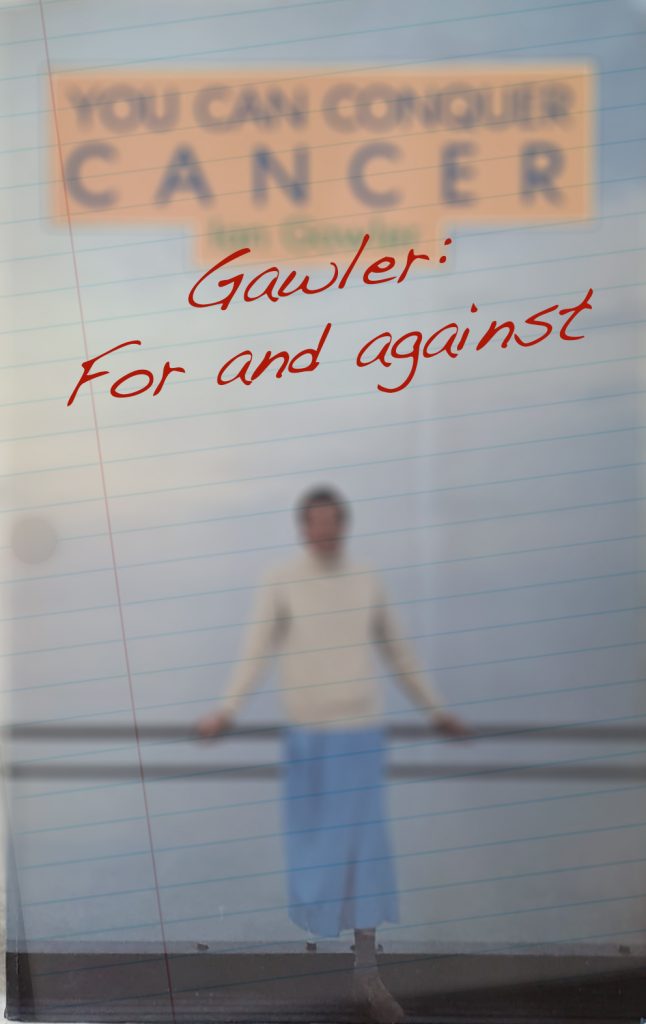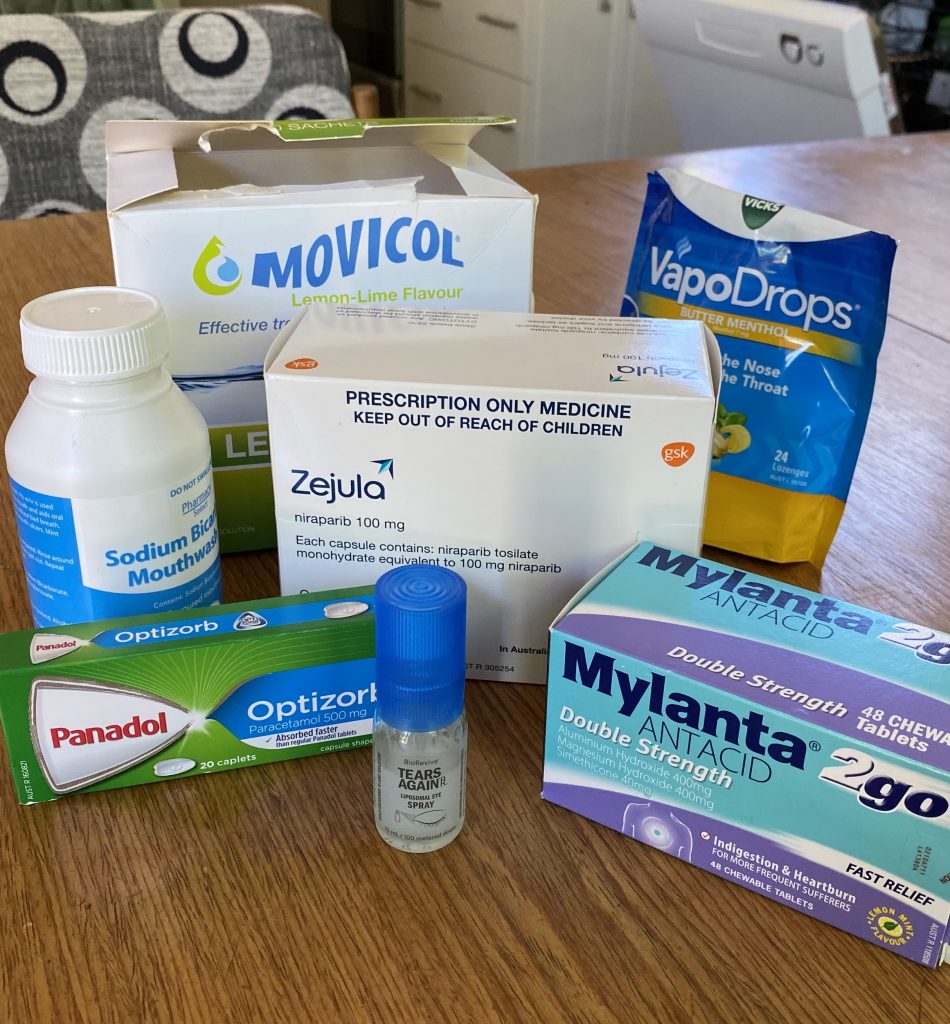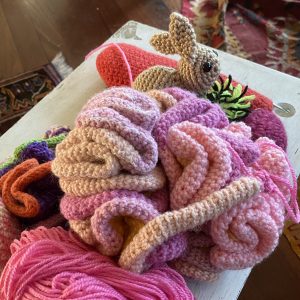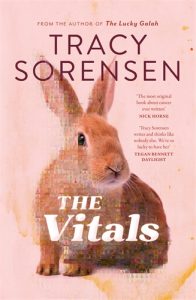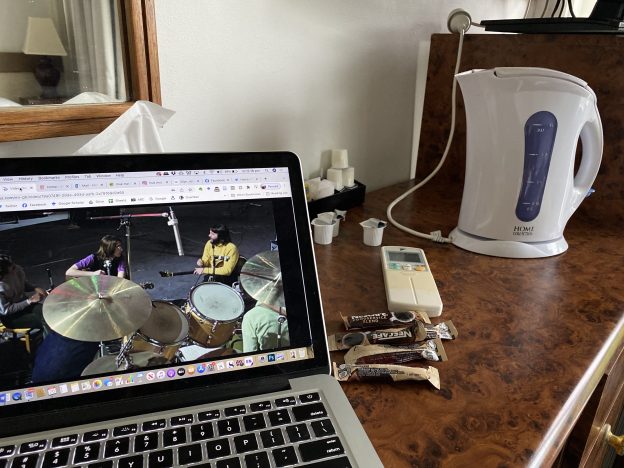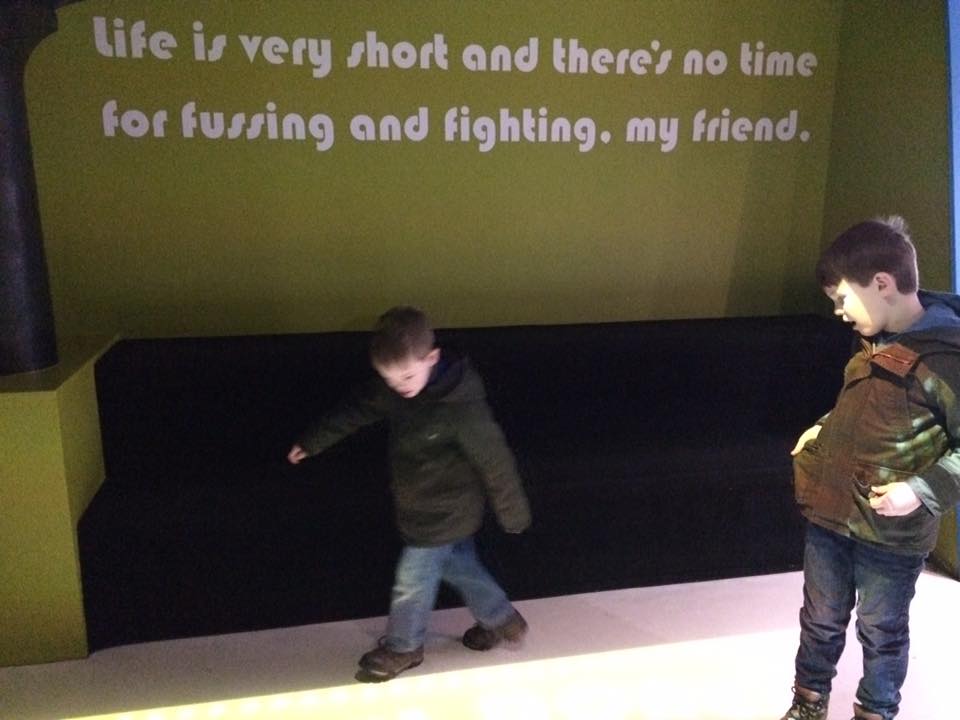Many of you will have heard of Ian Gawler, author of the best-selling book, first published in 1984, You Can Conquer Cancer. Like The Lucky Country, the title of the book is a sort of ambient phrase in Australian culture. Even if you haven’t read the book or paid much attention, its four bold words lurk somewhere in the background. I’ve been thinking about the book since washing the dishes on Saturday afternoon while listening to a podcast featuring Tim Baker, author of Patting the Shark. Tim’s book is a both a beautifully-written cancer memoir and a plea for a more wholistic approach to cancer treatment. Rather than dropping an earth-shattering diagnosis on people and leaving them to it, Tim says doctors should be directing their patients to information about diet, exercise, meditation, counselling and even other supportive activities such as writing workshops. Treat the whole person, not just a body part. In the podcast, Tim, who is living well and for a long time in the aftermath of a metastatic prostate cancer diagnosis, repeated a striking quote from Ian Gawler, with which I wholeheartedly agree (I’ll come back to this below).
But first, I want to set out the case against Gawler’s claim that you can conquer cancer, just as he did. Gawler’s claim, that he cured his metastatic bone cancer using diet and meditation, was always intriguing to me, but not particularly salient until I first got cancer myself, back in 2014. Then it came more sharply into focus as a way of thinking about cancer and science and medicine. While my first response to my diagnosis was Nuke it. Gimmee everything you got., I had people telling me there was another way. There was an alternative to mainstream medicine with its phalanx of scans, tests, chemotherapy, radiation, immunotherapy, surgeries, drugs and searing side-effects. There were more “natural” ways to treat cancer.
Yes, there are always other ways, other choices to be made, when confronting a shattering diagnosis. There could be any number of reasons for rejecting conventional cancer treatment. At an individual level, they’re all valid responses. What concerns me is how Gawler’s enormously influential book plays into what seems to me to be a growing rejection of, or misunderstanding of, the scientific method.
Okay, one more thing to get out of the way before I go on: Ian and Ruth Gawler would vehemently dispute my use of the word “alternative” to describe their approach to medicine. They prefer to use the phrase lifestyle medicine, describing this as a way of focusing on “what we can do for ourselves to recover from illness, and improve our prognosis and symptoms”. Their website does not advocate the Gawler program as something you should do instead of conventional cancer treatment. Their website simply sets out the case for the benefits of lifestyle interventions, meditation in particular. I also want to acknowledge that thousands have found Gawler’s meditation retreats enormously helpful.
But. But. Gawler’s great persuasive power rests on his claim that he conquered his metastatic cancer through lifestyle medicine after conventional treatments had stopped working. It is a claim that has come under intense scrutiny in recent years. Claims such as Gawler’s – intentionally or not – give credence to all sorts of quacks and shysters operating in the cancerverse. In 2014, as I was undergoing sometimes gruelling chemotherapy and surgery for advanced cancer, Belle Gibson was looking gorgeous, being feted by the media, gaining a national profile, and making a lot of money. Gibson was claiming that she had had terminal brain cancer (and a host of other types of cancer), and that she had cured herself by “natural” means, mainly diet. Her recipe app had been downloaded 200,000 times within its first month. A lavish cookbook based on her recipe collection was published by Lantern Books (an imprint of Penguin Australia) in October 2014. By March 2015, Gibson’s whole house of cards was crashing down. She was forced to admit she had never had cancer, and that her whole enterprise had been based on a tissue of lies. Penguin withdrew the book from sale (although you can still get it on eBay) and apologised for not scrutinising Gibson’s clearly controversial claims. All those involved in promoting Gibson quietly withdrew with their various tails between their legs.
A decade later, Gibson might be gone from the scene, but the snake oil continues. A quick Google search produces a piece published by Yahoo! News last Wednesday titled How to survive cancer without chemotherapy? by Roman Franco. “There is a great variety of alternative treatments to fight this terrible disease and the best option in this area is located in the city of Tijuana, Baja California,” writes Franco. The puff-piece for BahaMed lists treatments including “special diets, high vitamin dosages, laser therapies, emotional balance therapies, immunotherapies among others”; these are described as “minimally invasive” with low side-effects. (BahaMed’s particular modus operandi for getting desperate people to part their cash is is detailed in this piece by McGill University‘s Office for Science and Society.) Closer to home, Apricot Seeds Australia claims that a concoction made up of the juice of 1 beet, 1 carrot, 1 celery stick, half a potato and a radish is a “cancer killer”.
Gawler’s intentions are no doubt far from the Belle Gibsons and apricot seed purveyors, but that ambient phrase, You can conquer cancer, and widespread knowledge of his own particular cancer story, has been out in the world since 1984, doing its own work.
The fact is that there is no peer-reviewed scientific evidence that lifestyle medicine, used instead of conventional cancer treatment, can cure cancer or produce long-lasting remission. Claimed cases of complete remission brought about in the absence of conventional treatments tend to falter under sustained interrogation. Investigation often reveals that surgery, chemotherapy, immunotherapy, radiation or other conventional treatments were used at some point along the road. Or what was thought to be cancer was actually a misdiagnosis. Oncologists Ray Lowenthal and Ian Haines argue that Ian Gawler’s primary cancer might have been completely removed when surgeons amputated his leg back in 1975, and that what appeared to be secondary cancer may actually have been tuberculosis, which can look similar on X-rays. Anita Moorjani‘s spectacular remission after a near-death experience may have owed more to chemotherapy than she allows. In conversations with people claiming to know someone who had cured their own cancer “naturally”, I’ve noticed that they get vague when asked about the details of diagnoses and treatments. They can’t tell me the names of the diagnosing doctors or whether the person had had conventional treatment somewhere along the line. As I said, every choice is a valid one for people with cancer. How we do this is up to us, whether that’s about relying on prayer or meditation or doing nothing at all and simply letting things run their course. But if you really do want the best shot at extending your life or going into remission, the science is clear: conventional medical treatments are where it’s at. There are no guarantees, but they give you the best shot.
My other beef with You Can Conquer Cancer is that sometimes, you really can’t. You might go into remission, only to have the cancer come back within months. You might try every therapy under the sun, and find that it still gets you in the end. Sadly, this is a very common story. The phrase, You Can Conquer Cancer, feeds the idea that to “lose” the “battle” with cancer is to fail to be positive enough, courageous enough, disciplined enough. As a person living with an inherited genetic mutation that dramatically increases the risk of breast and/or ovarian cancer, it makes me angry. I’m sure the cancer-conquering narrative is not meant to make people like me feel bad – quite the opposite, I’m sure – but I can’t help feeling a distinct lack of compassion, a judgemental tone, in the idea that it’s all down to me to take control of my own destiny and “win”.
Actually, it’s laughable. Can I conquer cancer? Little old me? Really? The idea is individualism gone mad. The other day I watched the first episode of the ABC TV series The Chemical World presented by biomedical engineer Dr Jordan Nguyen (this came out three years ago; I saw it on iView). In it, Nguyen discussed the common DNA that exists in human beings and sea sponges. Yes, it would appear that you and me and sea sponges all have a common animal ancestor. DNA mutation (“errors” in copying genetic information) drove the process of evolution that allowed us to branch off from our spongy cousins, grow fingers and eventually learn to crochet. Genetic mutation, whether inherited (the BRCA1 gene mutation, for example) or acquired from the environment (from a lifetime of smoking, for example), is what causes cancer. Damaged or faulty genetic coding makes cells go rogue, multiplying recklessly, threatening the host organism and, ultimately, their own lives (they go down with the ship). So, genetic mutation comes as a job lot: on the one hand it gave us a pathway out of the primordial soup; on the other, it can cause cancer. Cancer is as natural as a sea sponge. That I might be able to “conquer” an ancient force like genetic mutation, all by myself, seems ridiculous to me. Yes, as a species, drawing on millennia of accumulated knowledge and skill, human beings might be able to pull off a cure for cancer. That day may be coming soon; bring it on! But me? With nothing but my own food choices, exercise regime and YouTube meditation clips, I can extinguish the fast-growing tumours inside me? No, I don’t think so.
Just to be clear, I’m not saying that meditation, diet, yoga, tai chi, exercise and a host of other “lifestyle” measures are not enormously helpful for people with cancer (and people in general). In some cases the benefits are backed by scientific research; others may be anecdotally effective but have not (yet) been through rigorous trials. A therapy may go all the way from “alternative” to “mainstream” after extensive clinical trials. Cannabis and magic mushrooms now have a place in mainstream medicine due to scientific evidence that they do help some people to cope with serious mental and physical illnesses. As Tim Minchin entertainingly put it, “alternative” medicine that is backed by scientific evidence is actually just … medicine.
Another thing to clear up is the difference between alternative (untested or tested and found ineffective) therapies and complementary medicine. Alternative therapies are used instead of conventional medicine; complementary therapies are used alongside conventional treatment (often with great results). Tim Baker calls this taking his MEDS. This stands for Meditation, Exercise, Diet and Sleep. His MEDS are self-prescribed, and he attributes his quality of life to them. But he also undergoes conventional treatments when indicated. Once again: A healthy lifestyle can help prevent cancer, and improve quality of life after diagnosis, but the evidence is clear: it can’t, on its own, cure it.
I’m also keen to dismantle the false division between “natural” and “unnatural” products or therapies or lifestyles. Nothing on this Earth (in “this dimension” at least – see footnote below) stands outside of the fundamental facts of nature, of physics and chemistry. In that sense, everything is “natural”, by definition. Chamomile has been used for centuries for its calming, sedative effects. Studies like this one provide a scientific explanation for what many have experienced. It’s a folk remedy with scientific backing. Taxol, a substance originally derived from the Pacific Yew Tree, has been shown to be an effective treatment for ovarian cancer, but because it is used in chemotherapy, it is seen as “unnatural” by some in the alternative medicine camp. So why is one plant-based substance natural and the other not? Arguing about whether something is or isn’t “natural” doesn’t make much sense. What makes more sense is finding out about how things actually work, and whether they help or hinder the goal of maintaining human (and non-human) health. Ingesting the tiny bit of arsenic that is found in apple seeds? No problem. A teaspoonful of concentrated arsenic added to a cup of tea? Death within minutes.
I’m concerned that the baby (science) is being thrown out with what I acknowledge is really filthy bathwater (the predatory inclinations of Big Pharma, Big Food, industrial polluters, etc). I want to say: That baby is precious. By all means throw out the bathwater, but don’t send her down the drain along with it. We need to acknowledge that this biosphere, and the universe as it is gradually revealed to us, operates according to rules (of physics and chemistry) that must be heeded.1 The scientific method means that over time, we replace good explanations with even better ones. We used to think the Sun revolved around the Earth. That explanation made perfect intuitive sense, and served most of the purposes of daily life. There’s the Sun, rising in the East and setting in the West. You can see it with your own eyes! After much scientific discussion (and the odd accusation of heresy), most of us now agree that the Earth orbits the Sun. This explanation is now supported by a mountain of evidence (including successful moon landings). As a society, when it comes to making decisions like action on climate change, or whether to allow a particular drug to come onto the market, our decisions need to be based on evidence, not on wishful thinking or intuition or belief or the loudest voices.
Of course, Western science is not the only way to achieve wellbeing and sustainability. Sixty thousand years of sustainable living on this continent shows us that. First Nations peoples threaded the rules of sustainability and health for all living things – care for Country – through every aspect of their culture. Today, the scientific method can help modern industrial societies return to principles such as constraint and a respect for non-human creatures. How many parts per million of carbon dioxide in the atmosphere will tip us into unliveable global warming? What can we do about outbreaks of blue-green algae that kill fish in the millions? Of course, science can be used to work out how to maximise salt and sugar in children’s food to make it addictive, or to track and catch the last fish in the sea. Science, like the English language or the telephone, is a tool. It’s how we use it that matters.
And now, finally (this might be my longest blog post ever; thank you for hanging in there), I’ll return to Ian Gawler’s striking quote, as repeated by Tim Baker in the podcast I was listening to as I did the dishes.
“I did a couple of retreats with a guy named Ian Gawler, the noted cancer survivor, and Ian said something that’s always stayed with me,” said Tim. “He said, ‘An acceptance of one’s mortality is entirely compatible with the will to live’.”
Like Tim, I find this a powerful and refreshing statement. I want to live, and yet I accept that at some point, along with all other living things, I’m going to die. Life, like genetic mutation, is a job lot. Life holds death in its belly; life is unimaginable without death. To really embrace these two facts, together, rather than hang on grimly to one while denying the other, is to suddenly feel the preciousness of life.
“When it’s actually embodied, when you actually feel it in your bones that life is temporary, then everything’s enhanced,” said Tim. “You know, I felt like my life was in high definition.”
I, too have had moments of life in high-definition. Cancer certainly focuses the mind. You look at a flower, or clouds in a blue sky, or a kelpie shaking water off itself, and want to cry over them because they are all so beautiful and you have taken them for granted.
- At least in this physical world, the one we were all thrown into at birth, the one that affects us and that we affect. There may be other worlds in the multiverse that operate according to different rules; we may be living in a giant simulation; we may leave this vale of tears and go somewhere much nicer after death, or come back over and over again until we’ve learned our damn lesson. These are all interesting possibilities. But they’re outside the scope of this blog post. ↩︎
